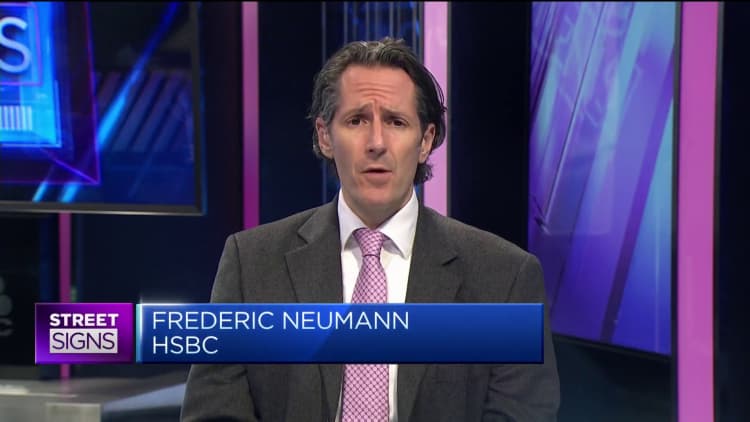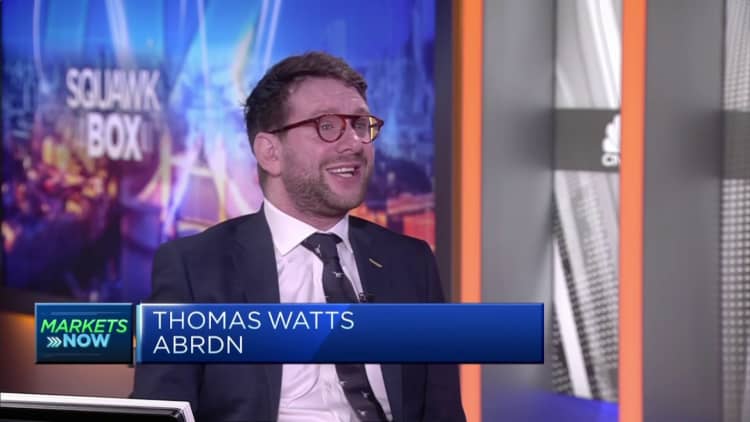European Central Bank (ECB) President Christine Lagarde gestures as she speaks to the media following the Governing Council monetary policy meeting at the ECB headquarters in Frankfurt, Germany, on December 14, 2023.
Kai Pfaffenbach | Reuters
Major Western central banks have all kept interest rates unchanged in recent days, but struck very different tones during highly anticipated market cuts in 2024.
THE US Federal Reserve sent risk assets rallying on Wednesday when in addition to keeping its benchmark rate within its current target range of 5.25% to 5.5%, the Federal Open Market Committee revealed that policymakers were draw at least three cups next year and four additional reductions in 2025.
Markets are now pricing in the first 25 basis point cut in March and expect the federal funds rate to be around 150 basis points lower by the end of next year, according to the tool FedWatch from the CME group.
Although the three cuts reported by the Fed were still below market expectations, they still came as a dovish surprise that sent the Dow at a record high and bond yields fell, with the US Treasury at 10 years the yield falls below 4% for the first time since July.
Overall inflation in the United States stood at an annual increase of 3.1% in Novemberstill above the Fed’s 2% target, but down significantly from the pandemic peak of 9.1% in June 2022. However, the base figure – which excludes commodity price volatility food products and energy – remained stable at 4%.
At the same time, economic activity has remained remarkably resilient, with GDP grows at an annual rate of 5.2% in the third trimester.
Fed Chairman Jerome Powell acknowledged during his news conference Wednesday that rate cuts have now started to “appear,” prompting a number of economists and major lenders to change their future rate forecasts.

Among them were US economists at Barclays, who previously forecast just one rate cut in December 2024, but now expect three cuts at every other meeting, starting in June.
“We were surprised by the FOMC’s reluctance to oppose the notable easing of financial conditions over the past month,” they said.
“Not only did the press release report “tighter financial and credit conditions…” as in November, but the SEP (summary of economic projections) also showed a slightly downward GDP growth projection for 2024 despite conditions less restrictive for aggregate demand. Powell expressed no concerns. that such easing could undermine the FOMC’s objectives.
Despite the dovish change in the rate announcement, the British bank’s economists attributed upside risk to its projections, as the recent easing of financial conditions “could boost growth and ultimately lead to a halt to disinflation.” .
A more perilous picture in the United Kingdom
On the other side of the Atlantic, however, the situation is very different. Both bank of england and the European Central Bank On Thursday, they pushed back against market expectations, drawing attention to persistent price and wage pressures in the domestic market.
THE bank of england kept its main interest rate unchanged at 5.25%, but far from putting rate cuts on the table, said monetary policy “will likely have to be restrictive for a prolonged period.”
Headline inflation in the UK fell to 4.6% on an annual basis in October, its lowest level in two years but well above the Bank’s 2% target. In the meantime wage growth was also lower than expected recently, but at more than 7%, still remains too high for the central bank.
The Bank of England’s Monetary Policy Committee noted that “key indicators of persistent inflation in the UK remain high”, even as tighter monetary policy leads to a looser labor market and weighs on the activity of the real economy.
UK real GDP remained stable in the third quarter but the economy unexpectedly shrank 0.3% month-on-month in October.

S&P Global said the BoE still faced a difficult task in determining the appropriate time to start easing policy, especially as it was accused of delaying tackling runaway inflation, which peaked at 11.1% in October 2022.
Senior economist Raj Badiani said the 6-3 vote to keep rates steady on Thursday, with the three dissenting members favoring another 25 basis point hike, indicates the MPC is not yet ready to consider rate reductions in a context of stubborn service. inflation, which has put steady earnings growth on a “challenging trajectory.”
“We expect four interest rate cuts next year, with the first taking place in August 2024. However, we recognize that this could be negatively affected due to the persistence of high service inflation and inflation underlying growth and unsustainable earnings growth,” Badiani said.
“Monetary policy is very restrictive, which is likely to trigger a mild recession in the coming quarters. In addition, the economy is expected to contract slightly over the whole of 2024.”
The ECB will remain “sufficiently restrictive”
The European Central Bank also maintained rates by lowering its growth and inflation forecasts and announcing its intention to accelerate the reduction of its balance sheet.
“Future decisions by the Governing Council will ensure that its policy rates are set at sufficiently restrictive levels for as long as necessary,” the ECB said in its accompanying statement.
However, he changed his language in describing inflation from “expected to remain too high for too long” to a claim that it “will gradually decline over the next year.”
Year-on-year inflation in the Eurozone moderated from 10.6% in October 2022 to 2.4% in the latest figure in November, putting the ECB’s 2% target within reach hand, although officials warn that wage pressures and energy market volatility could trigger a resurgence. .

Even though the ECB’s inflation forecasts have been revised downwards in the short term, core inflation for 2025 has been surprisingly revised upwards, and the ECB’s new forecasts for 2026 still place inflation underlying surface above the lens at the end of the projection horizon.
“Despite the hawkish messaging at (Thursday’s) meeting, the recent round of weaker-than-expected inflation data, the Fed’s pivot, as well as the softening of rhetoric from a number of prominent Board members of governors, have shifted the balance of risks around the ECB’s policy trajectory,” said Peter Schaffrik, global macro strategist at RBC Capital Markets.
“While we continue to believe the ECB will keep rates unchanged in 2024, we believe the risks now lean firmly towards earlier rate cuts.”
However, interpretations of ECB President Christine Lagarde’s press conference have varied. Although it pushed back market expectations for a first measure as early as March, some economists saw the overall message as opening the door to rate cuts at some point in 2024.
“Although (Lagarde) stressed that the ECB’s approach depends on data rather than time, she dropped at least four clues suggesting that a first cut seems more likely from June 2024 rather than at the start of 2024,” said Holger, Berenberg’s chief economist. Schmieding.
These allusions were: a reference to a “plateau” between the last hike and the first cut; the emphasis on the resilience of domestic inflation, mainly driven by wages; a reminder that the ECB’s projections that headline inflation is expected to fall to 2.1% in 2025 are based on market expectations for average 3-month overnight interest rates, which have reached their limit on November 23, rather than current market prices; and a deluge of new data expected in the first half of 2024.
“It is telling that the ECB’s monetary policy statement did not change the wording of the rate outlook. As before, the ECB committed to fixing rates at “sufficiently restrictive levels for as long as necessary” to guarantee a return of inflation to the 2% target. We continue to expect an initial decline of 25 basis points in the third quarter of 2024,” Schmieding said.


